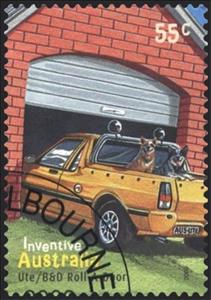Stamp: Roll-a-door, from m/s (Australia 2009)
Roll-a-door, from m/s (Australia 2009)
19 February (Australia ) within release Inventive goes into circulation Stamp Roll-a-door, from m/s face value 55 Australian cent
| Stamp Roll-a-door, from m/s in catalogues | |
|---|---|
| Michel: | Mi:AU 3156C |
Stamp is vertical format.
From miniature sheetAlso in the issue Inventive:
- Stamp - Wine Cask face value 55;
- Stamp - Wine Cask, from m/s face value 55;
- Stamp - Hills Hoist face value 55;
- Stamp - Hills Hoist, from m/s face value 55;
- Stamp - Zinc Cream/speedos face value 55;
- Stamp - Zinc Cream, from m/s face value 55;
- Stamp - Roll-a-door face value 55;
- Stamp - Roll-a-door, from m/s face value 55;
- Stamp - Victa Rotary Mower face value 55;
- Stamp - Victa Rotary Mower, from m/s face value 55;
- Stamp - Wine Cask face value 55;
- Stamp - Hills Hoist face value 55;
- Stamp - Zinc Cream/speedos face value 55;
- Stamp - Roll-a-door face value 55;
- Stamp - Victa Rotary Mower face value 55;
- Souvenir Sheet - Australian Inventive face value 2.75;
Stamp Roll-a-door, from m/s it reflects the thematic directions:
A car is a wheeled, self-powered motor vehicle used for transportation and a product of the automotive industry. Most definitions of the term specify that cars are designed to run primarily on roads, to have seating for one to eight people, to typically have four wheels with tyres, and to be constructed principally for the transport of people rather than goods. The year 1886 is regarded as the birth year of the modern car. In that year, German inventor Karl Benz built the Benz Patent-Motorwagen. Cars did not become widely available until the early 20th century. One of the first cars that was accessible to the masses was the 1908 Model T, an American car manufactured by the Ford Motor Company. Cars were rapidly adopted in the United States of America, where they replaced animal-drawn carriages and carts, but took much longer to be accepted in Western Europe and other parts of the world.
An invention is a unique or novel device, method, composition, idea, or process. An invention may be an improvement upon a machine, product, or process for increasing efficiency or lowering cost. It may also be an entirely new concept. If an idea is unique enough either as a stand-alone invention or as a significant improvement over the work of others, it can be patented. A patent, if granted, gives the inventor a proprietary interest in the patent over a specific period of time, which can be licensed for financial gain.


